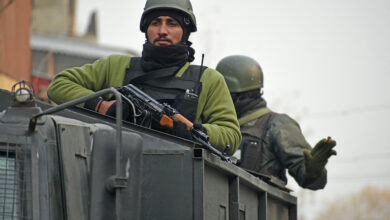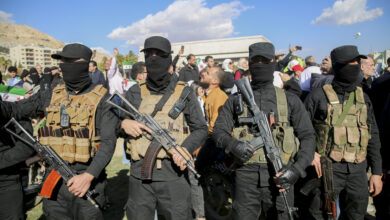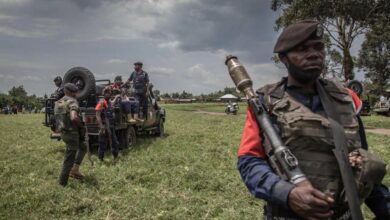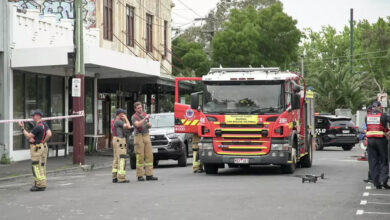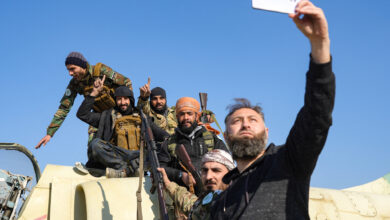Northern Ireland: Journalist shot dead during rioting in Derry
Police are treating the shooting as a terrorist incident
A woman was shot dead during rioting in the Creggan area of Derry city in the northwest of Northern Ireland on Thursday, April 18, police said.
“Sadly I can confirm that following shots being fired tonight in Creggan, a 29-year-old woman has been killed,” Police Service of Northern Ireland Assistant Chief Constable Mark Hamilton said. “We are treating this as a terrorist incident and we have launched a murder enquiry.”
The woman has been identified by colleagues and police as journalist Lyra McKee.
Hamilton said on Friday that police believe she was murdered “by a violent dissident republican,” adding that the group known as the New IRA was believed to be behind the attack.
@PSNIDCSDistrict name the journalist who was killed as Lyra McKee. They have now launched a murder investigation. "New IRA primary line of inquiry".
— Elaine McGee (@Elaine_McGee10) April 19, 2019
McKee is only the second reporter to be killed in Northern Ireland since the late 1960s. The other, Martin O’Hagan, was assassinated in Lurgan in September 2001.
The Creggan area is an Irish republican heartland and dissident republicans have been blamed for the incident. It comes ahead of Easter weekend, when republicans mark the anniversary of the 1916 Easter Rising against British rule in Ireland.
According to journalists on the scene, a crowd had gathered after police conducted a major operation and house searches in Mulroy Gardens, and petrol bombs, fireworks and stones were thrown at police on nearby Fanad Drive.
Hamilton said Friday that the searches, which began just after 9 p.m. (2000 GMT) “were being carried out because we believed that violent dissident republicans were storing firearms and explosives for a number of planned attacks and these may have been used over the Easter weekend in the city.”
https://twitter.com/LeonaONeill1/status/1118985436100202497
Later, a flat-bed truck and a car were reportedly hijacked and set alight in Fanad Drive.
https://twitter.com/LeonaONeill1/status/1118997204675506176
Shots were fired at around 11 p.m., striking the woman who, according to journalist Leona O’Neill, was near a police Land Rover. McKee was rushed to hospital in a police vehicle but later died.
Shots have been fired at police during rioting in Derry's Creggan estate. A woman was taken to hospital – unclear at this stage how she was injured. Earlier petrol bombs were thrown at police armoured vehicles, and a hijacked van and car were set on fire. @UTVNews pic.twitter.com/5KwXmCn3f9
— Mark McFadden (@MarkMcFadden) April 18, 2019
Videos shared on social media appeared to show at least two shots being fired from a handgun by a person beside a metal fence near a small burned-out flat-bed truck. The Defense Post cannot confirm the authenticity of the video.
https://twitter.com/niallcarsonpa/status/1119023764442947584
Dissident republican activity
In January, a car bomb exploded outside a courthouse in Derry. The New IRA was blamed for that attack.
Since then, a number of weapons caches have been uncovered in the southeast of Northern Ireland and just across the border in Ireland.
On April 8, Police Service of Northern Ireland officers recovered a horizontal mortar tube and command wire during an operation near Castlewellan in County Down.
A month earlier, the PSNI uncovered what they called a “significant terrorist hide” of mortar parts, including tubes, in a forested area near Forkhill close to the border on March 6.
A week prior, police uncovered a “sizeable” quantity of ammunition during a search near Omeath in County Louth as part of a follow-up operation targeting the activities of dissident Irish republican groups after Gardaí (Irish police) found a mortar tube and a “substantial” quantity of ammunition in the area on February 1.
Dissident Irish republicans have also taken credit for a series of explosive devices sent to Great Britain in March, with the New IRA claiming they sent four mail bombs that were recovered in London and Glasgow. A fifth “viable device” was discovered at the National Returns Letter Centre in Limerick after it had been returned by the postal service from the United Kingdom.
The 1998 Good Friday or Belfast Agreement ended what is known as The Troubles, three decades of violence in Northern Ireland beginning in the late 1960s in which more than 3,500 people were killed, the majority by predominantly Catholic Irish republicans who want the reunification of Ireland, but also by mainly Protestant loyalists who want Northern Ireland to remain part of the United Kingdom, as well as the security forces.
The violence also spilled over into Ireland, the United Kingdom mainland, and Europe.
The Irish Republican Army called a final ceasefire in 1997 and announced an end to its armed campaign in 2005, stating that it would seek to achieve its aims through peaceful political means, but various dissident Irish republican groups opposed to the peace process have continued to use the name IRA, and there have been sporadic violent incidents since.
The New IRA is the largest dissident Irish republican paramilitary group, formed in 2012 after a merger of several smaller groups with the Real IRA.
Police in Northern Ireland and Ireland have said that a return to a hard border on the island after Brexit could result in an increase in attacks by militant groups.






